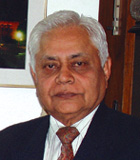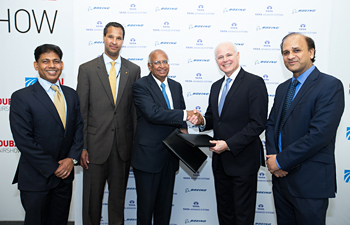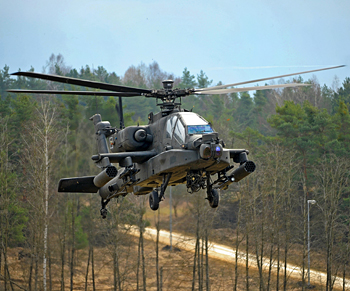INDIAN ARMED FORCES CHIEFS ON
OUR RELENTLESS AND FOCUSED PUBLISHING EFFORTS

SP Guide Publications puts forth a well compiled articulation of issues, pursuits and accomplishments of the Indian Army, over the years

I am confident that SP Guide Publications would continue to inform, inspire and influence.

My compliments to SP Guide Publications for informative and credible reportage on contemporary aerospace issues over the past six decades.
- Prime Minister witnesses 'Bharat Shakti' – a Tri-Services Firing and Manoeuvre Exercise in Pokhran, Rajasthan
- Interim Defence Budget 2024-25 — An Analysis
- Union Defence budget 2024
- Prime Minister Modi Commemorates Indian Navy Day in a Grand Ceremony
- Prime Minister Modi Flies in the LCA Tejas
- New Chapter in India-Italy Defence Ties
- Airpower beyond Boundaries
Boeing and TASL to form a Joint Venture

By Air Marshal B.K. Pandey (Retd)
Former Air Officer Commanding-in-Chief of Training Command, IAF
 Tata Advanced Systems Chairman S. Ramadorai (third from left) and Tom Bell, senior vice president, Global Sales & Marketing, Boeing Defense, Space & Security (second from right) sign the agreement to create a joint venture. Boeing International President, Marc Allen (second from left), Boeing India President Pratyush Kumar (left) and Tata Advanced Systems CEO Sukaran Singh (right) attended the signing ceremony.
Tata Advanced Systems Chairman S. Ramadorai (third from left) and Tom Bell, senior vice president, Global Sales & Marketing, Boeing Defense, Space & Security (second from right) sign the agreement to create a joint venture. Boeing International President, Marc Allen (second from left), Boeing India President Pratyush Kumar (left) and Tata Advanced Systems CEO Sukaran Singh (right) attended the signing ceremony.
 AH-64 Apache helicopter
AH-64 Apache helicopter
Photo Credit: Boeing, US Army
Joint ventures (JV) between foreign and Indian companies are not a new phenomenon for the industrial sector in India. Despite its insular nature, the Indian defence and aerospace industry entered into agreements for licensed production of military aircraft and weapons systems for which elaborate facilities were created within the country. The shining examples of military aircraft produced under licence are the several variants of the MiG-21 and the MiG-27 strike aircraft, the Hawker Siddeley HS-748 medium-lift transport aircraft jointly with a British aerospace major, the German Dornier Do 228 light utility platform, the Cheetah, Chetak and Cheetal rotary-wing platforms produced under licence from a French aerospace company. All these military platforms continue to render yeomen service with the Indian Air Force (IAF). Another major success recorded in JVs has been the Indo-Russian BrahMos supersonic cruise missile. The JV named BrahMos Aerospace was launched on February 12, 1998, between the state-owned Defence Research and Development Organisation (DRDO) and the Russian company NPO Mashinostroyenia. The first BrahMos cruise missile was launched on June 12, 2001. However, the Indian partner in all these cases of licensed production or JVs was the state-owned Hindustan Aeronautics Limited (HAL) in the case of the military platforms and the DRDO for the BrahMos cruise missile. The aerospace industry in the private sector for all practical purposes was non-existent or was tasked with manufacture of minor components.
But since the beginning of the current decade, signs of change for the better have begun to be visible in respect of the Indian aerospace industry in the private sector. Hyderabad-based TASL is a fully owned subsidiary of Tata Sons, entered into a JV with Sikorsky Aircraft Corporation to manufacture the Sikorsky S-92 helicopter in India for the domestic market as well as for export. So far, around 100 cabins of the S-92 have been manufactured all of which have been exported. In fact, it is understood that the next S-92 VVIP helicopter being inducted into the US Presidential Fleet will have its cabin made in India. Another TASL joint venture in India with Lockheed Martin has been producing aerostructures for the C-130 Hercules and its variants. But the most laudable achievement for TASL has been the clearance in May this year by the Indian Government of the proposal by Airbus Defence and Space-TASL JV for the manufacture in India of 40 of the CASA C-295 medium-lift military transport aircraft for the IAF and later possibly for foreign markets. And now the tie up with Boeing to manufacture aero-structures for the Apache attack helicopters in India will be an impressive feather in its cap.TASL is also planning to foray into the domain of unmanned aerial vehicles (UAV). The aim is to manufacture these platforms through collaboration with Israel Aerospace Industries (IAI) for the Indian armed forces as also for civilian applications.
But TASL is not the only one in the private sector that is making waves. In July this year, Airbus Helicopters announced plans to partner with Indian company Mahindra Defence, a unit of Mahindra Group, to produce helicopters in India. As per Guillaume Faury, President and CEO, Airbus Helicopters, the JV company will manufacture state-of-the-art helicopters of high reliability, quality and safety standards based on combat-proven platforms for the Indian armed forces. On parallel track, Russian Helicopters are to partner with Reliance Defence and Aerospace, a new company under the Ambani Group, to manufacture 200 of the Kamov 226T light utility helicopters for the IAF and the Indian Army. There is a possibility that this order could be doubled.
The Indian defence and aerospace industry is on the threshold of a new era that will be characterised by higher levels of self-reliance in the manufacture of military aircraft and weapon systems. The Indian Government is expected to spend around $600 billion over the next decade. Undoubtedly, there are immense opportunities for the major players in the Indian aerospace and defence industry in the private sector. The list of companies in the private sector that can make meaningful contribution to this national effort is long and growing. The ‘Make in India’ theme of Prime Minister Narendra Modi is now set to soar to unprecedented heights!
 |
By Air Marshal B.K. Pandey (Retd) Former Air Officer Commanding-in-Chief of Training Command, IAF |


Photo Credit: Boeing, US Army
Joint ventures (JV) between foreign and Indian companies are not a new phenomenon for the industrial sector in India. Despite its insular nature, the Indian defence and aerospace industry entered into agreements for licensed production of military aircraft and weapons systems for which elaborate facilities were created within the country. The shining examples of military aircraft produced under licence are the several variants of the MiG-21 and the MiG-27 strike aircraft, the Hawker Siddeley HS-748 medium-lift transport aircraft jointly with a British aerospace major, the German Dornier Do 228 light utility platform, the Cheetah, Chetak and Cheetal rotary-wing platforms produced under licence from a French aerospace company. All these military platforms continue to render yeomen service with the Indian Air Force (IAF). Another major success recorded in JVs has been the Indo-Russian BrahMos supersonic cruise missile. The JV named BrahMos Aerospace was launched on February 12, 1998, between the state-owned Defence Research and Development Organisation (DRDO) and the Russian company NPO Mashinostroyenia. The first BrahMos cruise missile was launched on June 12, 2001. However, the Indian partner in all these cases of licensed production or JVs was the state-owned Hindustan Aeronautics Limited (HAL) in the case of the military platforms and the DRDO for the BrahMos cruise missile. The aerospace industry in the private sector for all practical purposes was non-existent or was tasked with manufacture of minor components.
But since the beginning of the current decade, signs of change for the better have begun to be visible in respect of the Indian aerospace industry in the private sector. Hyderabad-based TASL is a fully owned subsidiary of Tata Sons, entered into a JV with Sikorsky Aircraft Corporation to manufacture the Sikorsky S-92 helicopter in India for the domestic market as well as for export. So far, around 100 cabins of the S-92 have been manufactured all of which have been exported. In fact, it is understood that the next S-92 VVIP helicopter being inducted into the US Presidential Fleet will have its cabin made in India. Another TASL joint venture in India with Lockheed Martin has been producing aerostructures for the C-130 Hercules and its variants. But the most laudable achievement for TASL has been the clearance in May this year by the Indian Government of the proposal by Airbus Defence and Space-TASL JV for the manufacture in India of 40 of the CASA C-295 medium-lift military transport aircraft for the IAF and later possibly for foreign markets. And now the tie up with Boeing to manufacture aero-structures for the Apache attack helicopters in India will be an impressive feather in its cap.TASL is also planning to foray into the domain of unmanned aerial vehicles (UAV). The aim is to manufacture these platforms through collaboration with Israel Aerospace Industries (IAI) for the Indian armed forces as also for civilian applications.
But TASL is not the only one in the private sector that is making waves. In July this year, Airbus Helicopters announced plans to partner with Indian company Mahindra Defence, a unit of Mahindra Group, to produce helicopters in India. As per Guillaume Faury, President and CEO, Airbus Helicopters, the JV company will manufacture state-of-the-art helicopters of high reliability, quality and safety standards based on combat-proven platforms for the Indian armed forces. On parallel track, Russian Helicopters are to partner with Reliance Defence and Aerospace, a new company under the Ambani Group, to manufacture 200 of the Kamov 226T light utility helicopters for the IAF and the Indian Army. There is a possibility that this order could be doubled.
The Indian defence and aerospace industry is on the threshold of a new era that will be characterised by higher levels of self-reliance in the manufacture of military aircraft and weapon systems. The Indian Government is expected to spend around $600 billion over the next decade. Undoubtedly, there are immense opportunities for the major players in the Indian aerospace and defence industry in the private sector. The list of companies in the private sector that can make meaningful contribution to this national effort is long and growing. The ‘Make in India’ theme of Prime Minister Narendra Modi is now set to soar to unprecedented heights!





